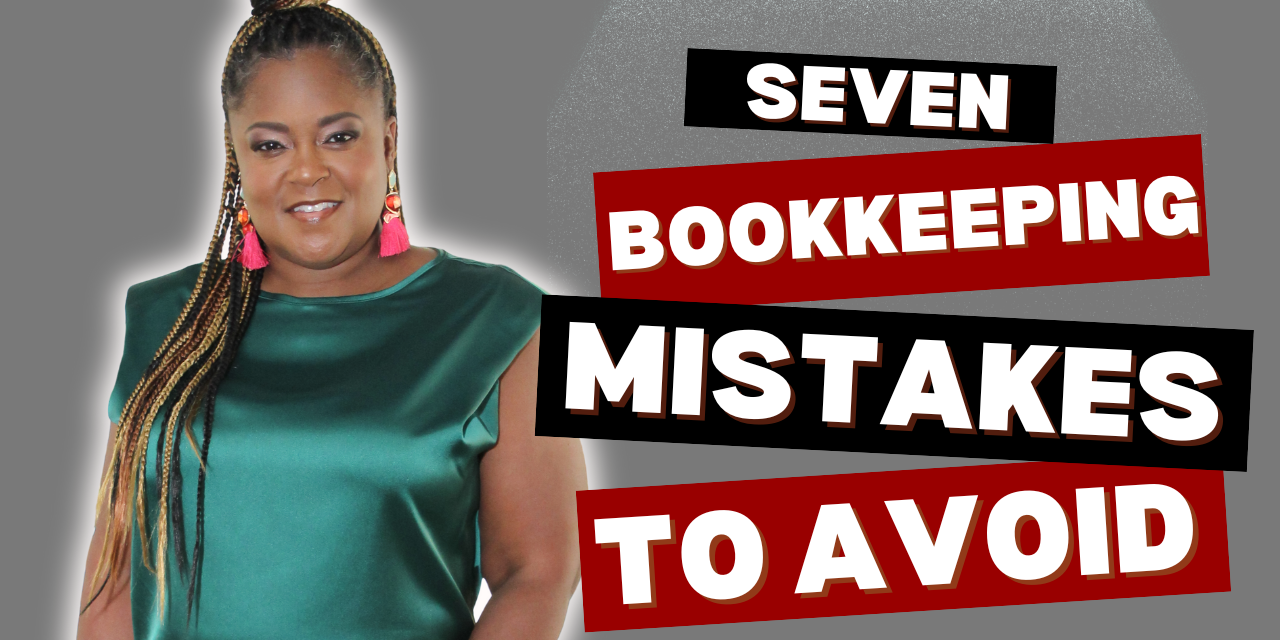I’m sharing the seven most common bookkeeping mistakes I see in small businesses and agencies, why they matter, and exactly how to avoid them.
Whether you’re building a seven-figure agency, running a side business, or just getting started as a bookkeeper, there are seven common bookkeeping mistakes I see small businesses and agencies make.
Here’s the thing, bookkeeping doesn’t have to be overwhelming. With a few good habits and the right setup, you can clean up the books, stop money leaks, and make smarter decisions all year long. This will allow you to generate financials that provide clarity and confidence; not stress. Below I will unpack each mistake, explain the impact, and provide specific, actionable steps you can take today.
Why fixing bookkeeping mistakes matters
Clean books are more than just compliance, they are a business intelligence system. When financial data is clear and timely, you can spot cash flow problems earlier, assess which clients or projects are profitable, prepare accurate budgets, and pay the right amount of tax without surprises. On the flip side, messy books create stress, misinformed decisions, and missed opportunities.
Mistake 1: Mixing business and personal finances
Mixing business and personal bank accounts is one of the biggest no-nos. It might feel convenient at first, but it clouds your financial picture and causes trouble at tax time. You maybe thinking “this doesn’t apply to me” but here’s what I see – small businesses running business expenses through personal accounts and 7-figure business owners running personal expenses through their business accounts.
To deduct an expense, it must be both ordinary and necessary for the business.
If a payment isn’t both ordinary and necessary, it’s not deductible. Running business transactions through a personal account, or vice versa, increases the chance of misclassified expenses and audit headaches. It also makes it hard to measure true business performance.
How to fix it:
- Open a separate business checking account and business credit card the day you start taking in revenue.
- Pay personal expenses from personal accounts and business expenses from business accounts. If a personal expense is paid from the business account by mistake, treat it as an owner draw or repayment and record it correctly.
- Set up payroll or owner distributions for owners who need regular income instead of relying on random transfers.
Mistake 2: Not recording transactions right away
Waiting weeks or months to update the books is a recipe for lost receipts, forgotten transactions, and inaccurate financial reports. I recently worked with a client whose prior CPA updated the books monthly. Trying to reconstruct months of activity can led to errors and guesswork.
Why timeliness matters:
- Memories fade and receipts disappear.
- Bank feeds can miss details if not reviewed regularly.
- Timely books let you see cash flow and adjust before small issues become big problems.
How to fix it:
- Develop a routine and update books weekly at minimum; businesses with many transactions may need daily updates.
- Use receipt-scanning apps (your phone camera + cloud storage) and link them to your bookkeeping software.
- Automate bank feeds but review and approve transactions regularly; automation is helpful, not hands-off.
- Create a short checklist for your bookkeeping session: bank feed review, categorize uncategorized transactions, attach receipts, and reconcile.
Mistake 3: Ignoring small expenses
Those $5 coffees, $8 app subscriptions, and recurring micro-payments add up. Small expenses are often overlooked because they feel insignificant, but cumulatively they can create a meaningful drain on cash flow.
Common culprits:
- Unused or duplicate subscriptions with auto-renewals.
- Numerous low-value purchases (coffee, parking, small supplies).
- Micro-payments from team members or contractors that don’t get tracked.
How to fix it:
- Run a “subscription audit” quarterly. Identify recurring charges, confirm who uses them and whether they’re still needed. If you haven’t used it in 3 months, chances are you won’t use it at all.
- Where possible and switch to annual billing to reduce costs. Keep in mind that if you cancel later, you may not be able to get a refund for unused months, so choose annual billing wisely.
- Set a petty cash (yes, some businesses still use this) or minor-expense policy. Consider a threshold (e.g., require receipts for anything over $25) and reconcile petty cash regularly.
- Use reports to monitor expense categories month to month. Look for unusual upticks and investigate immediately.
Mistake 4: Not reconciling accounts
Reconciliation is the simple act of ensuring your books match the bank and other statements. Skipping reconciliations invites errors to persist and automation tools, including AI, can misclassify transactions.
Why reconciliation matters now more than ever:
- Automation is powerful but imperfect. AI can categorize wrong vendor payments or split transfers incorrectly.
- Reconciling catches timing differences, bank fees, failed payments, and duplicate charges.
- It gives you confidence that the numbers reported to owners and advisors are accurate.
How to fix it:
- Reconcile bank accounts, credit cards, merchant accounts, and loans monthly
- When reconciling, look for outstanding checks, pending transactions, and transfers between accounts that may explain differences.
- Take notice of any uncleared items and set a plan to research them if they haven’t cleared within 3 months and void if uncleared within 6 months.
- Keep a dedicated clearing or suspense account for temporary items; investigate and clear it monthly.
Mistake 5: Overcomplicating the chart of accounts
The chart of accounts is meant to organize your data so it’s usable. Too many accounts make reports noisy and financial analysis ineffective. A crowded chart of accounts hides what matters.
Best practices:
- Keep account names clear and consistent. Use descriptive but concise category titles not vendor and customer names.
- Use subaccounts for detail only when it serves reporting needs. Don’t create an account for every niche expense unless you’ll actually use the report.
- Decide on a numbering system (or not). The important thing is that your team understands the structure.
- Periodically clean up the chart: merge unused accounts, fix misnamed accounts, and simplify categories.
Example structure to consider:
- Revenue by service line (e.g., Consulting Revenue, Managed Services Revenue)
- Cost of Goods Sold or Cost of Sales which are costs tied directly to revenue
- Operating Expenses grouped by function (Marketing, Software, Rent, Payroll)
- Other Income/Expenses that should be below operating income such as interest, depreciation and other one-time events
Mistake 6: Not tracking operations granularly enough
Many agencies and service businesses record all revenue and expenses in aggregate and miss the important question: which clients and projects are profitable? Lumping everything together loses the story that job-level data tells.
Why granular tracking matters:
- It reveals true client and project profitability.
- It allows you to price smartly and allocate resources efficiently.
- It uncovers which services drive profits and which are loss leaders.
How to fix it:
- Set up project/job tracking in your bookkeeping software. Tag transactions to clients, projects, or jobs.
- Track direct costs (freelancers, subcontractors, materials) against each job, and attribute time/costs consistently.
- Use KPIs such as gross margin per project, utilization rate, and realization rate to measure performance.
- Run project profitability reports monthly and discuss findings in leadership or client-review meetings.
Real-world example: a project billed $10,000 looked profitable on the surface. But after tracking subcontractor hours, rush fees, and unbillable revisions, you discover the project actually lost money. Without project tracking, that loss hides until it’s too late to adjust pricing or processes.
Mistake 7: Waiting until tax time
Putting bookkeeping off until tax season creates anxiety and increases the likelihood of errors and missed deductions. It also denies you the year-round insights you need to make decisions.
Consequences of waiting:
- Rushed, incomplete records and higher professional fees to fix books.
- Missed opportunities to plan for taxes and optimize cash flow.
- Greater chance of late filings, penalties, and missed credits.
How to fix it:
- Make bookkeeping a year-round discipline: monthly closes, quarterly reviews, and regular reconciliations.
- Estimate taxes quarterly if you expect to owe. This reduces surprises and helps with cash flow planning.
- Run quarterly financial reviews: profit & loss, balance sheet, cash flow forecast, and project profitability reports.
- Work with your accountant or CPA throughout the year, not just in March, so you can adjust strategy proactively.
Conclusion: bookkeeping without boundaries
Bookkeeping doesn’t need to be a source of dread. With clear policies, simple structure, disciplined routines, and the right tracking, you’ll build books that empower decisions instead of generating anxiety. Avoid the seven mistakes above and you’ll save time, stress, and money while gaining the peace of mind that comes with accurate, actionable financial information.
If you’re running an agency, which of these mistakes do you recognize in your own operations?
If you’re a new bookkeeper, which ones are you seeing most often with clients? Share your experience and questions I’d love to help. For bookkeeping professionals and career changers, we also offer community support and training that can help you level up your skills and systems.
Keep your books tidy, stay curious about your numbers, and run your business with intention. Take care!









